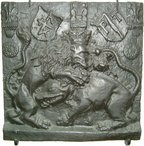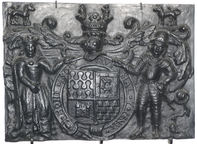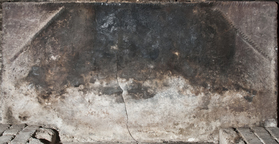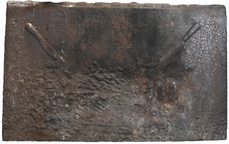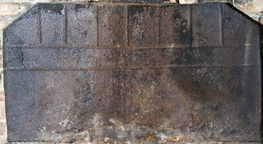-
739
Description: Rectangular; a crowned lion fighting a boar in high relief on a raised bottom panel; above, a stamp formed from a fleur-de-lys on a bracket repeated three times, centre left and right corners; two angled shields and two sunburst discs.
Notes: The shields probably signify civic or personal allegiance; the symbolism of the fighting beasts is not known. Part of the bequest to the Victoria and Albert Museum by Lieut. Colonel G. B. Croft-Lyons in 1926.
Inscription: P T
- Decoration tags:
- rectangular (shape)
- none (edging)
- whole carved pattern
- heraldic
- armorial
- text
- animals
Manufactured: in the late-16th to early-17th century in Germany.
Current location: Victoria & Albert Museum, Cromwell Road, Kensington & Chelsea, Greater London, England.
Museum number: M.576-1926 (part of the Victoria & Albert Museum museum group)
- Attached to series:
- Foreign armorial firebacks
-
740
Description: Plain rectangular plate; shield, garter, helm, mantling and supporters of the Blount family, Lords Mountjoy.
Notes: The arms are those of Charles Blount, 8th Baron Mountjoy, who was invested Knight of the Garter in 1597. He was created 1st Earl of Devonshire in 1603. Blazon: 1. (Blount) Barry nebuly of six Or and Sable; 2. (Ayala) Argent, two wolves passant Sable on a bordure of the first eight saltires Gules; 3. (Mountjoy) Or a tower Azure; 4. (Gresley) Vair. An unusually bold and detailed casting; the buckle missing from the garter suggests that this plate has been cropped from a larger fireback.
Inscription: HONI·SOIT·QVI·MAL·Y·PENSE
Arms: Charles Blount, KG, 8th Baron Mountjoy
- Decoration tags:
- rectangular (shape)
- none (edging)
- whole carved pattern
- armorial
- text
Manufactured: in the late-16th to early-17th century in England.
Current location: Victoria & Albert Museum, Cromwell Road, Kensington & Chelsea, Greater London, England.
Museum number: 323.1907 (part of the Victoria & Albert Museum museum group)
- Attached to series:
- Personal armorial firebacks
- Mountjoy series
-
1277
Description: Rectangular; twisted rope edging (top and sides only); rope diagonally length across each top corner.
Notes: A very simple rope design seen in several variations on other firebacks.
- Decoration tags:
- rectangular (shape)
- rope (edging)
- simple stamps
Manufactured: in the late-16th to early-17th century in the Weald area of England.
Current location: in private hands, Wadhurst, East Sussex, England.
- Attached to series:
- Rope design firebacks
-
1279
Description: Plain rectangular shape with chamfered and embattled top edge; impression of a utilitarian, domestic knife inclined, blade down, at an angle of about 45 degrees from inside the top corners; the knife measures about 20.5cm in length.
Notes: An unusual, if not unique, top edge. The form of the knife suggests a late-16th or early-17th century date. The uneven surface of the lower part of the fireback may have been caused by the pouring of the molten metal and the consequent disturbance of the casting sand of the mould.
- Decoration tags:
- rectangular (shape)
- none (edging)
- simple stamps
- objects
Manufactured: in the late-16th to early-17th century in the Weald area of England.
Current location: in private hands, Wadhurst, East Sussex, England.
-
1280
Description: Canted rectangular shape; twisted rope edging (top and sides); two approximately parallel horizontal lines of twisted rope across the upper centre; from the upper line and starting at the top corners, seven regularly spaced vertical lines of twisted rope extending to the top edge.
Notes: A simple rope design without apotropaic significance.
Copies of this fireback are known.
- Decoration tags:
- rectangular with canted top corners (shape)
- rope (edging)
- simple stamps
- objects
Manufactured: in the late-16th to early-17th century possibly in the Weald area of England.
Current location: in private hands, Wadhurst, East Sussex, England.
- Attached to series:
- Rope design firebacks
-
797
Description: Rectangular; twisted rope edging (top and sides); three impressions of an ornate firedog, each incorporating lion’s legs, above it a pedestal with a lion’s head, surmounted by a caryatid, a shield shaped cartouche over its lower trunk, and with a floral vase headdress. The dog impressions are not evenly stamped, the middle one lying to the right.
Notes: The firedogs are much more elaborate than those customarily used as stamps on firebacks and indicate a later date; they probably included brass elements and were possibly French.
- Decoration tags:
- rectangular (shape)
- rope (edging)
- simple stamps
- objects
Manufactured: in the late-16th to early-17th century in the Weald area of England.
Current location: in private hands, Wisborough Green, West Sussex, England.
- Attached to series:
- Firedog stamp firebacks
- Metalware stamp firebacks
